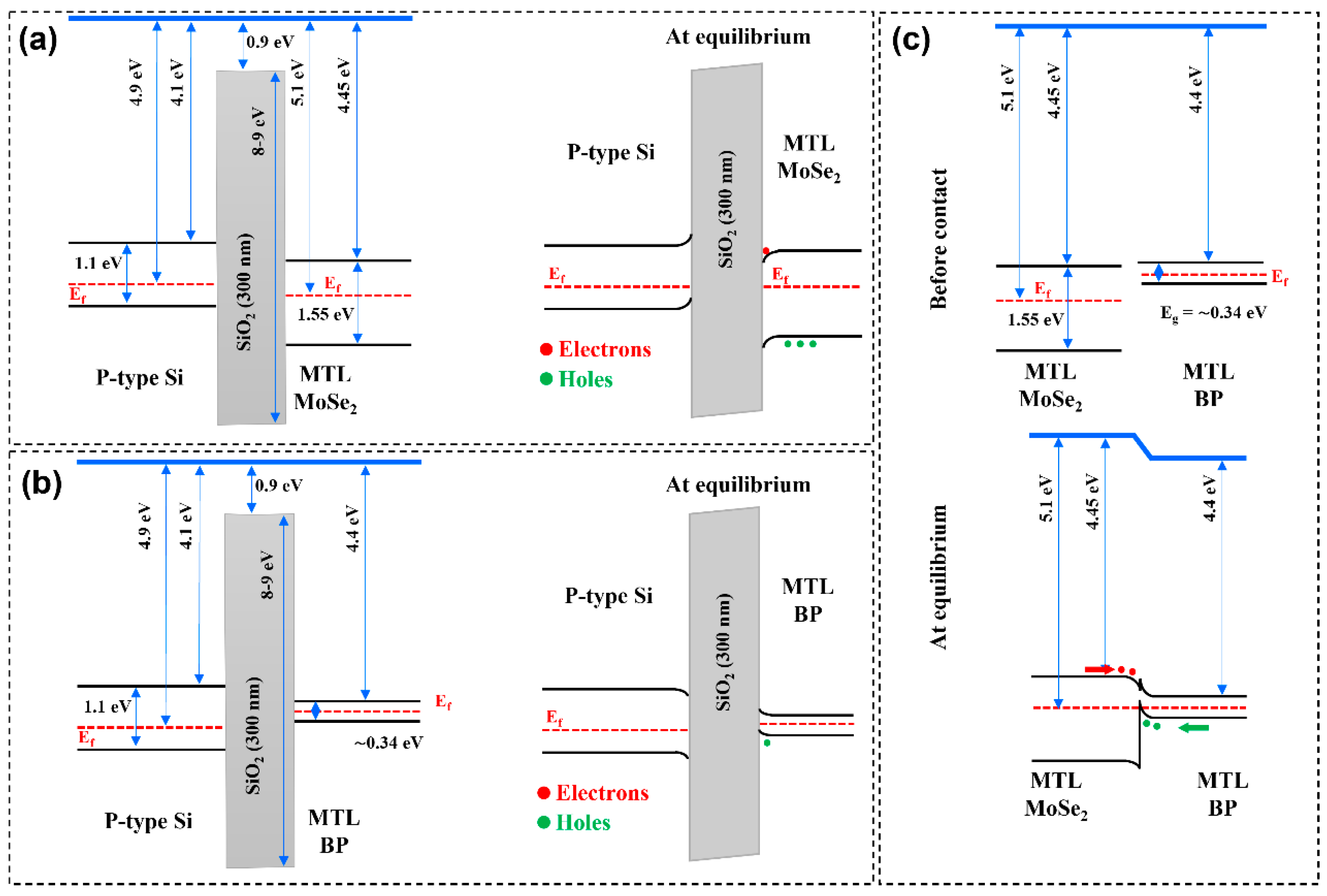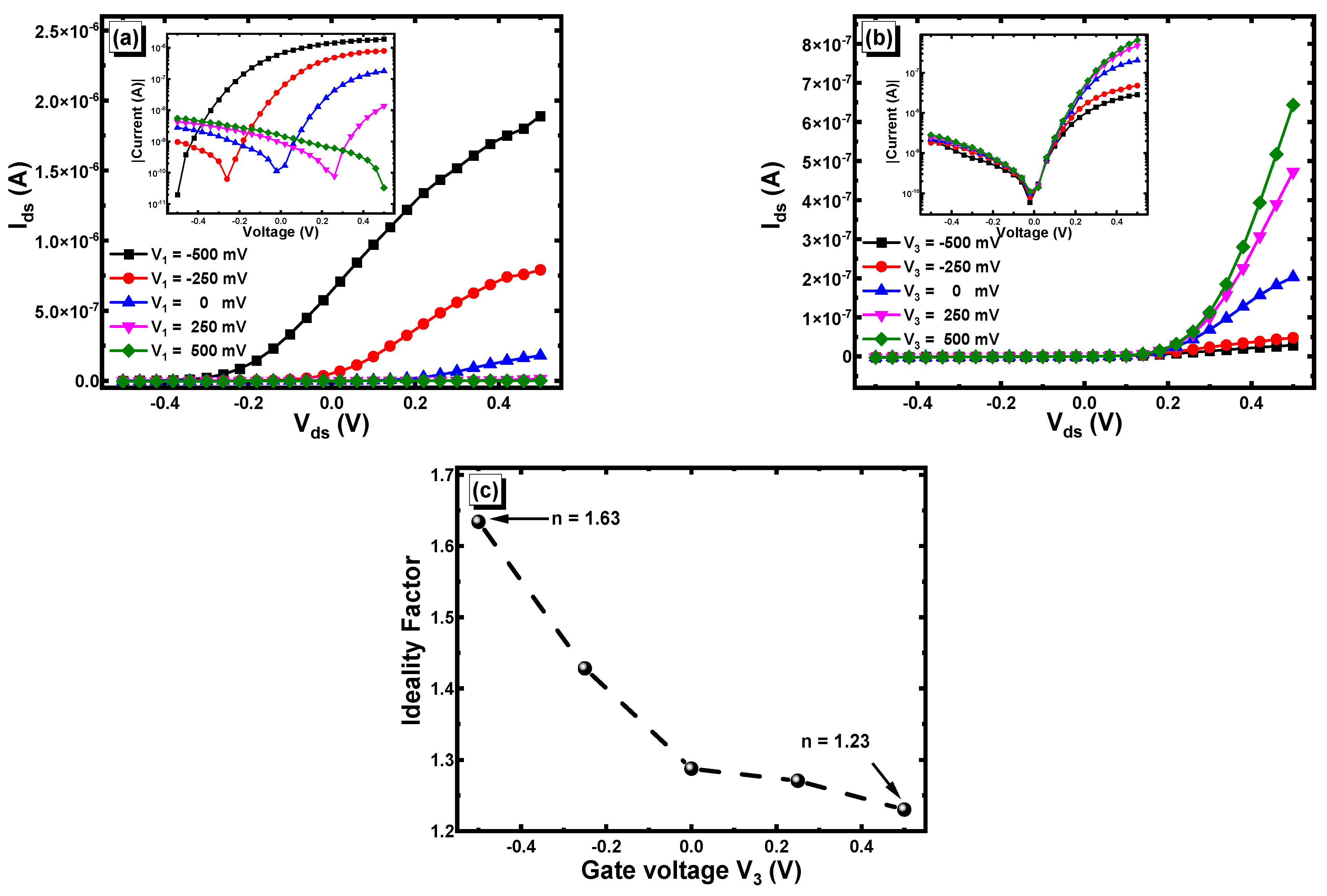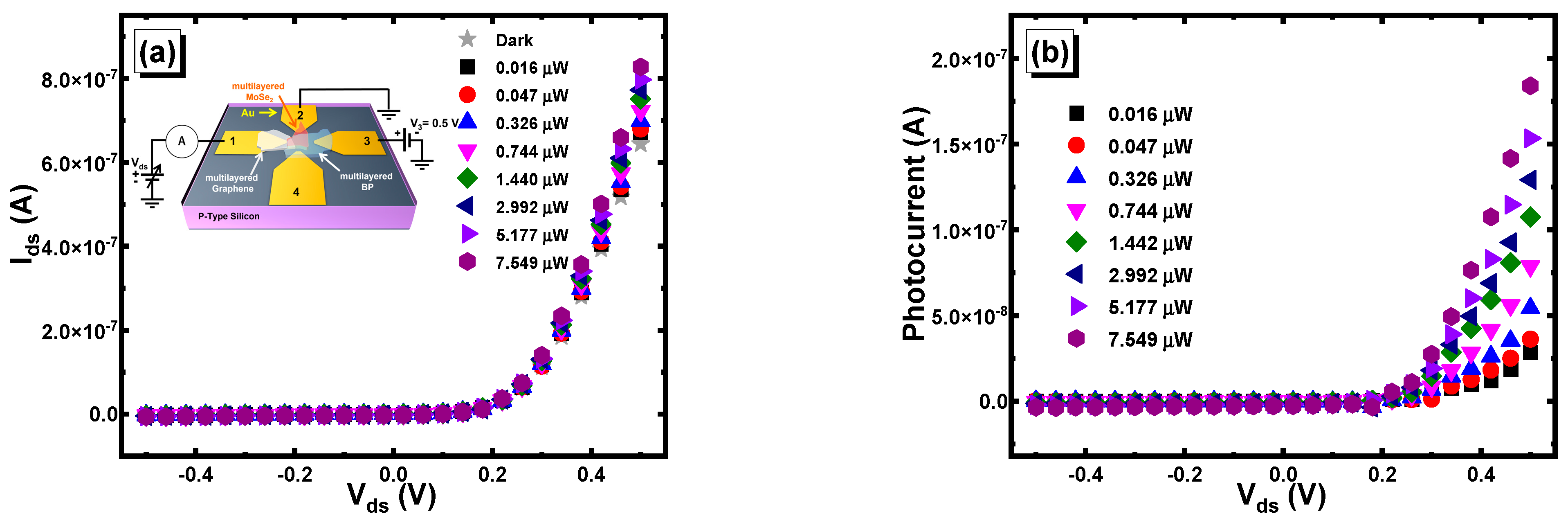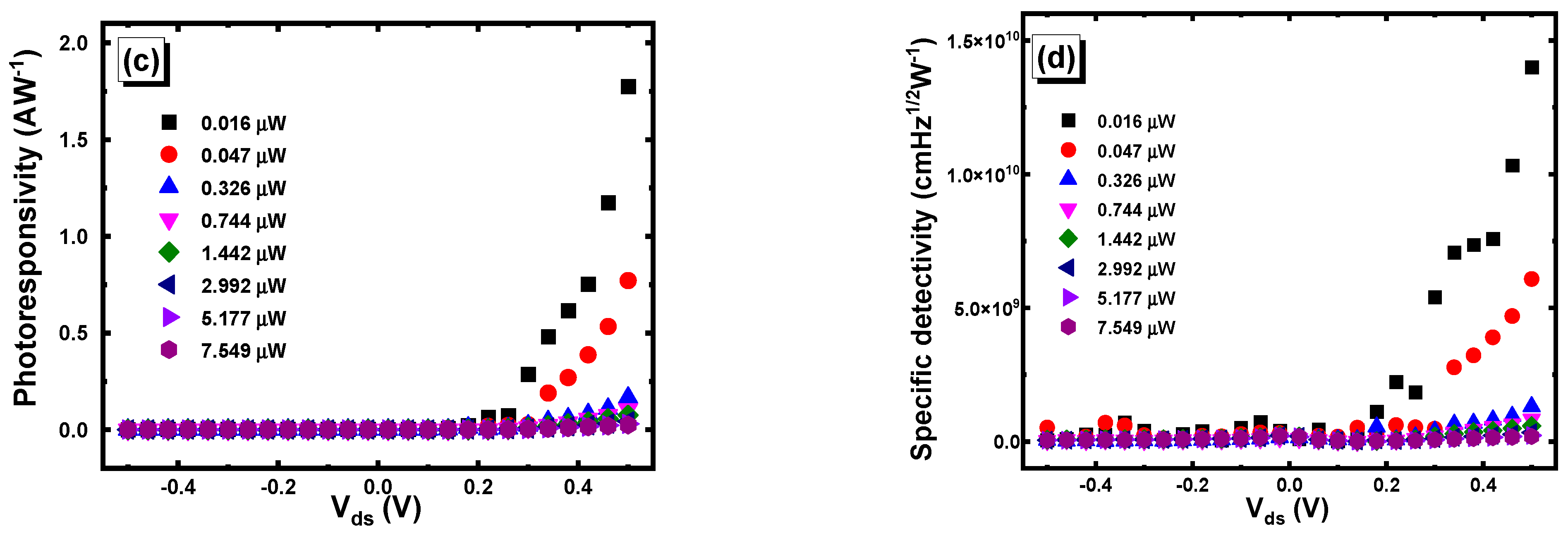Optoelectronic Properties of Hexagonal Boron Nitride Shielded Molybdenum Diselenide/Black-Phosphorus Based Heterojunction Field Effect Transistor
Abstract
:1. Introduction
2. Materials and Methods
3. Results and Discussion
3.1. Morphological Characterization
3.2. Energy Band Diagrams
3.3. Electrical and Optoelectronic Characterization
4. Conclusions
Supplementary Materials
Author Contributions
Funding
Institutional Review Board Statement
Informed Consent Statement
Data Availability Statement
Conflicts of Interest
References
- Paletti, P.; Yue, R.; Hinkle, C.; Fullerton-Shirey, S.K.; Seabaugh, A. Two-dimensional electric-double-layer Esaki diode. NPJ 2D Mater. Appl. 2019, 3, 1–7. [Google Scholar] [CrossRef]
- Liu, Y.; Huang, Y.; Duan, X. Van der Waals integration before and beyond two-dimensional materials. Nature 2019, 567, 323–333. [Google Scholar] [CrossRef] [PubMed]
- Fang, Y.; Ge, Y.; Wang, C.; Zhang, H. Mid-infrared photonics using 2D materials: Status and challenges. Laser Photonics Rev. 2020, 14, 1900098. [Google Scholar] [CrossRef]
- Xu, M.; Liang, T.; Shi, M.; Chen, H. Graphene-like two-dimensional materials. Chem. Rev. 2013, 113, 3766–3798. [Google Scholar] [CrossRef] [PubMed]
- Abderrahmane, A.; Oh, J.M.; Kim, N.H.; Ko, P.J.; Sandhu, A. Micro-Hall sensors based on two-dimensional molybdenum diselenide. J. Nanosci. Nanotechnol. 2019, 19, 4330–4332. [Google Scholar] [CrossRef] [PubMed]
- Abderrahmane, A.; Ko, P.J.; Jung, P.G.; Kim, N.H.; Sandhu, A. Optoelectronic characterizations of two-dimensional h-BN/MoSe2 heterostructures based photodetector. Sci. Adv. Mater. 2018, 10, 627–631. [Google Scholar] [CrossRef]
- Li, A.; Chen, Q.; Wang, P.; Gan, Y.; Qi, T.; Wang, P.; Tang, F.; Wu, J.Z.; Chen, R.; Zhang, L.; et al. Ultrahigh-sensitive broadband photodetectors based on dielectric shielded MoTe2/Graphene/SnS2 p–g–n junctions. Adv. Mater. 2019, 31, 1805656. [Google Scholar] [CrossRef] [PubMed]
- Li, J.; Luo, H.; Zhai, B.; Lu, R.; Guo, Z.; Zhang, H.; Liu, Y. Black phosphorus: A two-dimension saturable absorption material for mid-infrared Q-switched and mode-locked fiber lasers. Sci. Rep. 2016, 6, 30361. [Google Scholar] [CrossRef] [PubMed] [Green Version]
- Zong, X.; Hu, H.; Ouyang, G.; Wang, J.; Shi, R.; Zhang, L.; Zeng, Q.; Zhu, C.; Chen, S.; Cheng, C.; et al. Black phosphorus-based van der Waals heterostructures for mid-infrared light-emission applications. Light Sci. Appl. 2020, 9, 1–8. [Google Scholar] [CrossRef]
- Liu, F.; Huang, C.; Liu, C.X.; Shi, R.; Chen, Y. Black Phosphorus-Based Semiconductor Heterojunctions for Photocatalytic Water Splitting. Chem. Eur. J. 2020, 26, 4449–4460. [Google Scholar] [CrossRef]
- Hassan, Y.; Srivastava, P.K.; Singh, B.; Abbas, M.S.; Ali, F.; Yoo, W.J.; Lee, C. Phase-engineered molybdenum telluride/black phosphorus van der waals heterojunctions for tunable multivalued logic. ACS Appl. Mater. Interfaces 2020, 12, 14119–14124. [Google Scholar] [CrossRef] [PubMed]
- Chen, C.; Hu, J.; Yang, X.; Yang, T.; Qu, J.; Guo, C.; Li, C.M. Ambient-stable black phosphorus-based 2D/2D S-scheme heterojunction for efficient photocatalytic CO2 reduction to syngas. ACS Appl. Mater. Interfaces 2021, 13, 20162–20173. [Google Scholar] [CrossRef] [PubMed]
- Krishnamurthi, V.; Low, M.X.; Kuriakose, S.; Sriram, S.; Bhaskaran, M.; Walia, S. Black phosphorus nanoflakes vertically stacked on MoS2 nanoflakes as heterostructures for photodetection. ACS Appl. Nano Mater. 2021, 4, 6928–6935. [Google Scholar] [CrossRef]
- Abderrahmane, A.; Woo, C.; Ko, P.J. Black phosphorus/molybdenum diselenide heterojunction-based photodetector. J. Electron. Mater. 2021, 50, 5713–5720. [Google Scholar] [CrossRef]
- Gao, E.; Lin, S.Z.; Qin, Z.; Buehler, M.J.; Feng, X.Q.; Xu, Z. Mechanical exfoliation of two-dimensional materials. J. Mech. Phys. Solids 2018, 115, 248–262. [Google Scholar] [CrossRef]
- Yu, Y.J.; Zhao, Y.; Ryu, S.; Brus, L.E.; Kim, K.S.; Kim, P. Tuning the graphene work function by electric field effect. Nano Lett. 2009, 9, 3430–3434. [Google Scholar] [CrossRef] [PubMed] [Green Version]
- Hou, C.; Yang, L.; Li, B.; Zhang, Q.; Li, Y.; Yue, Q.; Wang, Y.; Yang, Z.; Dong, L. Multilayer black phosphorus near-infrared photodetectors. Sensors 2018, 18, 1668. [Google Scholar] [CrossRef] [PubMed] [Green Version]
- Hong, T.; Chamlagain, B.; Wang, T.; Chuang, H.J.; Zhou, Z.; Xu, Y.Q. Anisotropic photocurrent response at black phosphorus–MoS2 p–n heterojunctions. Nanoscale 2015, 7, 18537–18541. [Google Scholar] [CrossRef] [PubMed]
- Guo, Q.; Pospischil, A.; Bhuiyan, M.; Jiang, H.; Tian, H.; Farmer, D.; Deng, B.; Li, C.; Han, S.J.; Wang, H.; et al. Black phosphorus mid-infrared photodetectors with high gain. Nano Lett. 2016, 16, 4648–4655. [Google Scholar] [CrossRef] [PubMed] [Green Version]








Publisher’s Note: MDPI stays neutral with regard to jurisdictional claims in published maps and institutional affiliations. |
© 2022 by the authors. Licensee MDPI, Basel, Switzerland. This article is an open access article distributed under the terms and conditions of the Creative Commons Attribution (CC BY) license (https://creativecommons.org/licenses/by/4.0/).
Share and Cite
Abderrahmane, A.; Woo, C.; Ko, P.-J. Optoelectronic Properties of Hexagonal Boron Nitride Shielded Molybdenum Diselenide/Black-Phosphorus Based Heterojunction Field Effect Transistor. Coatings 2022, 12, 445. https://doi.org/10.3390/coatings12040445
Abderrahmane A, Woo C, Ko P-J. Optoelectronic Properties of Hexagonal Boron Nitride Shielded Molybdenum Diselenide/Black-Phosphorus Based Heterojunction Field Effect Transistor. Coatings. 2022; 12(4):445. https://doi.org/10.3390/coatings12040445
Chicago/Turabian StyleAbderrahmane, Abdelkader, Changlim Woo, and Pil-Ju Ko. 2022. "Optoelectronic Properties of Hexagonal Boron Nitride Shielded Molybdenum Diselenide/Black-Phosphorus Based Heterojunction Field Effect Transistor" Coatings 12, no. 4: 445. https://doi.org/10.3390/coatings12040445





